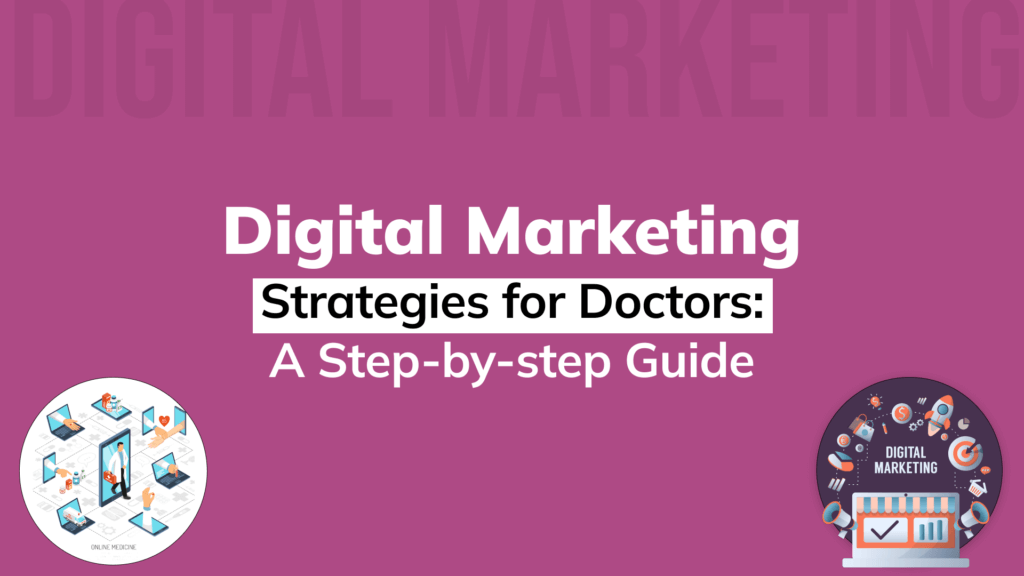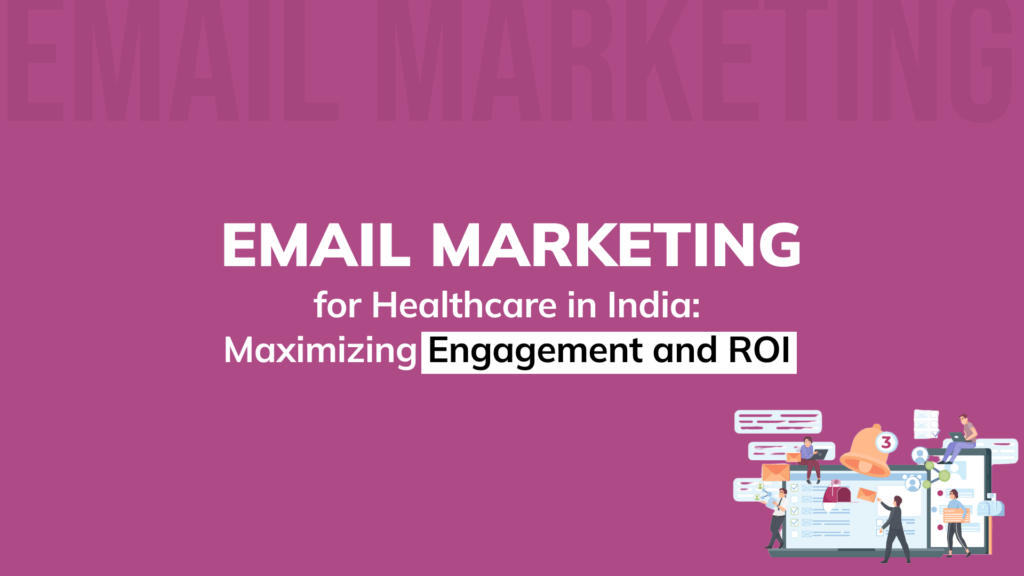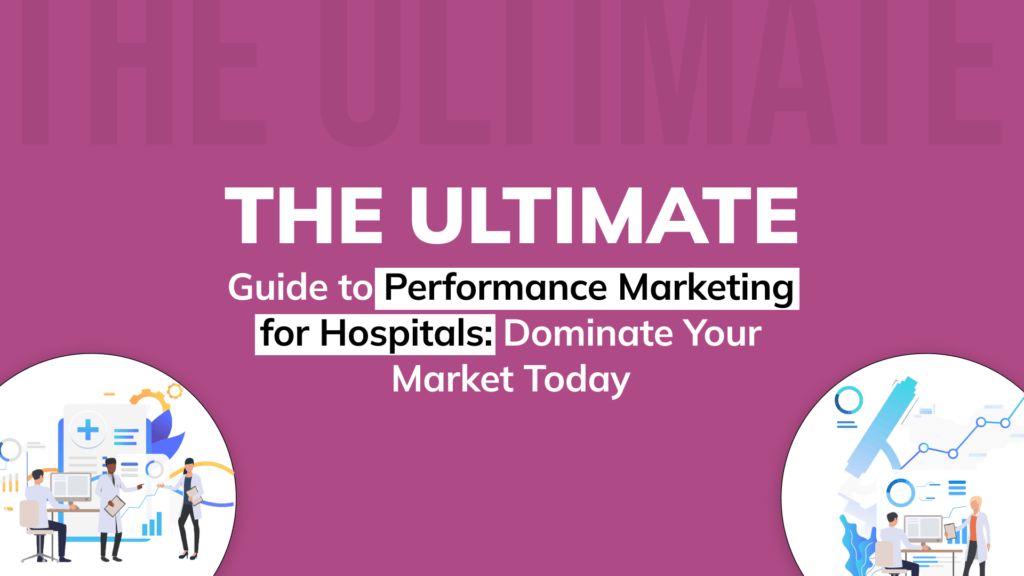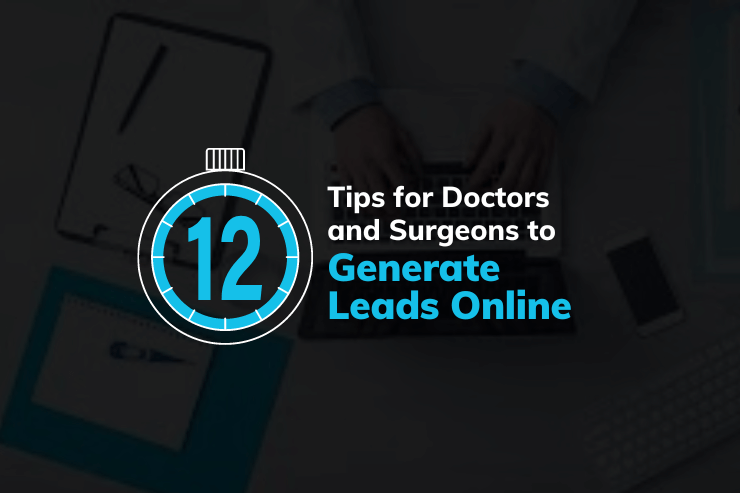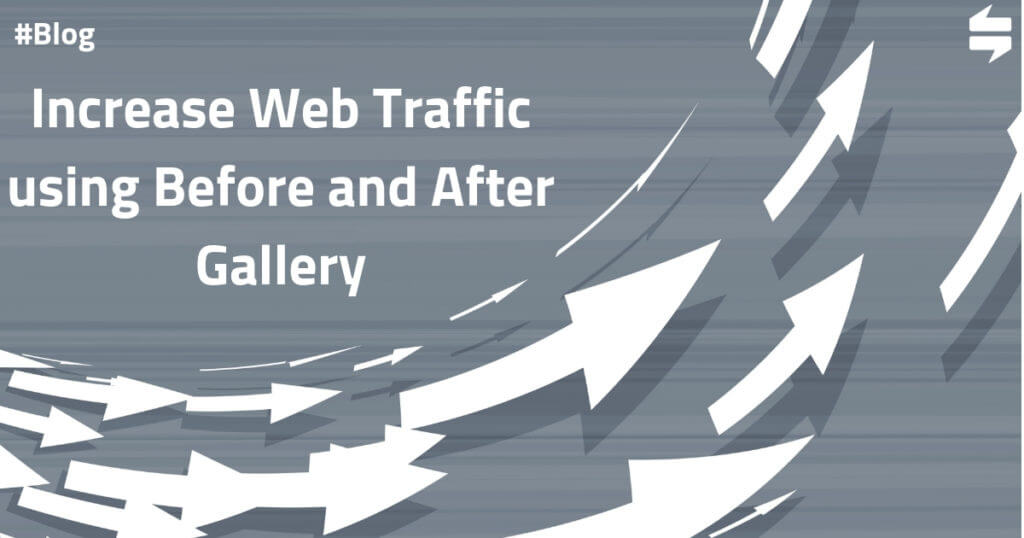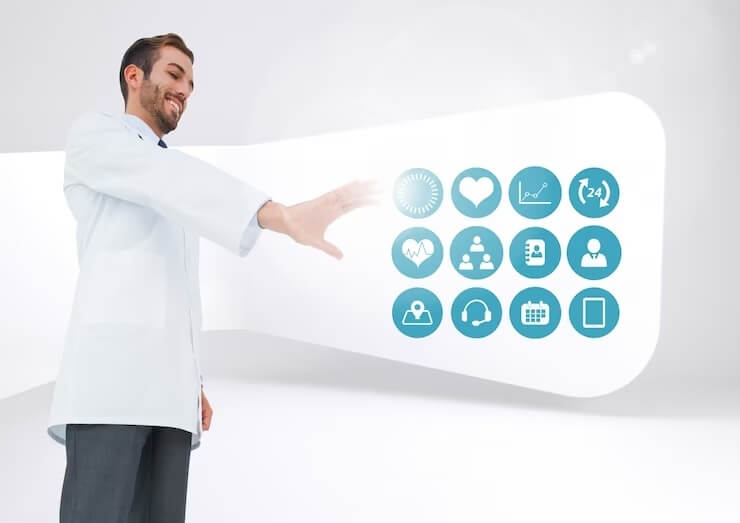Do you seek Google’s help when it comes to searching for the symptoms or treatment of any medical problem? You’re not alone if you think you can treat the disease by yourself. Many people do that. Searching online for the best treatment and then ends up searching for the best doctor.
And this search does not end here. You would want to know what other patients are saying about the services and treatment. Well, like any other service, the Internet is the first place people look for hospitals and doctors.
They could search for addresses, contact details, nearby hospitals, or patient reviews. This becomes a great opportunity for hospitals, small clinics, and independent practitioners to show up in the first row when their target audience is looking for them.
What do SEO trends in 2023 say about healthcare marketing? Let’s have a look-
- According to a survey, 77% of people use search engines like google to start their patient journey. (2023 Healthcare Marketing Statistics | Digitalis Medical)
- 7% of all google searches are related to health
- 70,000 healthcare searches are done every minute
- 8% patients use search engines to find a healthcare provider
- 83% book a doctor’s visit through website
The Importance of a Strong Online Presence for Hospitals
“1 in 20 google searches are about health and healthcare” (5 Reasons Your Hospital Should Be Investing in Digital (mdconnectinc.com))
Before getting to a few points, let’s first have a look at some of the critical statistics that speak volumes about the importance of digital presence for hospitals-
Studies show that 72% of people who have access to the internethave searched online for information concerning medical procedures or health issues, 47% of people search online for physicians, while 40% search online for information about clinics, hospitals, and other healthcare services. (ref link- Healthcare Digital Marketing And Its Importance | iTrobes)
Coming to the points-
- Improved patient engagement: Patients are very much likely to trust any healthcare provider that has a good online presence, genuine reviews, a well-built website, and social media profiles. This increases the credibility of the hospital and improves patient engagement.
- Increased patient acquisition:Healthcare providers can improve their visibility on search engines by optimizing their website, ranking higher will ease the process for individuals searching for medical service providers leading to an uptick in patient acquisition.
- Relevance of online reviews: A recent study showed that approx. 77% of patients use online reviews as their first step toward finding a new doctor. (refer- Embracing the Rise of Healthcare Consumerism | Healthgrades) . This emphasizes the significance of creating a strong online presence, including patient testimonials, to distinguish from competitors.
- Easy consultation and communication:The Internet can serve as your one-stop solution to communicate with your patients through e-mails, text messages, and phone calls. Patients can book an appointment or call for any health query. This saves time and avoidsunnecessary visits to the clinic. Digital presence can also enable online consulting.
- Digital savvy people: It’s been reported that 83% of patients visit a hospital website before booking an appointment. Nowadays, mobile devices are like a necessity, and everybody owns one. It takes less than a minute to search for a hospital website and browse through it. Digital-savvy people are more aware, they want to know the insights before they actually pay a visit to the hospital.
- Recruitment made easy: Recruiting talented medical professionals is a high priority for hospitals. Having quality staff facilitates a smooth patient experience and better treatment. You can use social media platforms like LinkedIn, Twitter, and Facebook to attract applicants.
Key Objective of Digital Marketing for Hospitals
The key objectives of Digital marketing for hospitals are mainly-
- Education- Educate patients about some serious health conditions, such as heart disease, and diabetes, and how to prevent them. Hospitals often come up with free health check-up camps to promote their services. The screenings allow people to take control of their underlying medical conditions and be more aware.
- Promote services– Healthcare marketing is all about helping patients access the services they need. By promoting specific services, like prenatal care, cancer screenings, hospitals help patients make informed choices. Social media campaigns, online videos, and patient outreach programs also help in promoting the services of hospitals.
- Building a brand name- Changes in the healthcare industry have impacted brand recognition among patients. The key goal of a healthcare marketing campaign is to show how a facility uses top-notch technology, smooth patient experience, and cost-effective care for its target market.
Key Digital Marketing Platforms for Hospitals-
- Google ads- It is a pay-per-click platform that allows healthcare providers to target their potential patients through search engine results and display ads.
- Facebook ads- Facebook ads allow hospitals to create and run ads on Facebook and Instagram.
- Hootsuite- It is a kind of management platform to effectively schedule, publish and monitor social media creatives across different platforms.
- Email marketing-It is a timeless way of reaching out to potential patients and keeping the current ones updated on the latest medical services and technologies.
- LinkedIn-It’s a great social media platform for hospitals to make professional connections, hire doctors, and medical staff and put ads to reach a wider audience.
How to target the right audience for hospitals and healthcare facilities-
Well, in healthcare marketing- it is a harsh truth that not every message will suit every set of audience. A health tip might work for your current patient but may not be effective for consumers and vice-versa.
Here comes this question how can you target the right audience and address everyone’s needs? Is it even possible? The answer is YES, with the right digital marketing strategy.
Target marketing is a way of marketing where hospitals can reach their potential patients through audience research, segmentation and more. To reach different segments like working women, children, elders, teenagers, and baby boomers- you need to change your message and marketing tactics.
- Identifying the target market- Identifying the target market in the healthcare sector is a crucial step in crafting a successful digital marketing strategy. Some of the most common target markets include-
- Age-based segments– This will include different age groups like infants, adults, children, and senior citizens. Each age group may have different healthcare needs.
- Geographic segments– This includes patients based on their locations- urban, sub-urban and rural. Different geographical demand different access to medical services.
- Income-based segments– This includes patients based on their income- low, medium and high class. They have different preferences when it comes to healthcare services, accordingly marketing strategies can be adjusted.
- Lifestyle segments– This includes patients based on their lifestyle. There are people who smoke, and on the other hand, people who follow a strict non-smoking regular exercise routine. Different lifestyles impact healthcare needs and preferences.
Maximizing social media for healthcare marketing-
If covid era has taught us anything, it’s- “healthcare and social media can be a very useful combination”. Social networks are vital for communication. With their help, you can convey well-being information to millions of people across the globe.
Benefits of social media in healthcare-
- Communication during a crisis– When a crisis hit, the very first place people go to seek news is social media. In the healthcare sector also, instead of going to the doctor- people generally search for an emerging health problem online. Its symptoms, treatment, latest news about it, history, and everything.
- Raising awareness– Social-mediacomes to the rescue when it comes to raising public awareness about new, emerging, and annual health concerns. During covid, many eminent hospitals and doctors conveyed information online only. As it was the only medium to communicate, social media made it easier for people to access emergency services and vaccines.
- Combating miscommunication- Fake news can become dangerous when it comes to health care. Innocent people tend to believe the word spread on the internet which can sometimes be life-threatening. Former US President Donald Trump got in trouble when he posted that coronavirus can be cured by injecting bleach into the body. The claim was widely disputed by healthcare professionals and social media was the only medium.
Take a look at some of the examples of how social media can be leveraged for communication during a crisis-
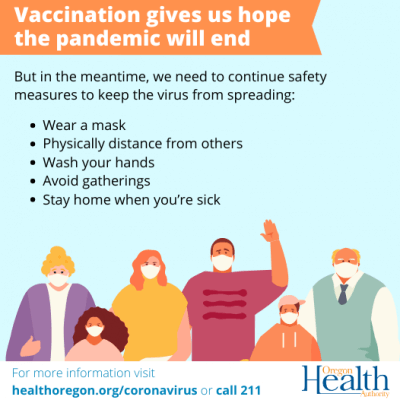
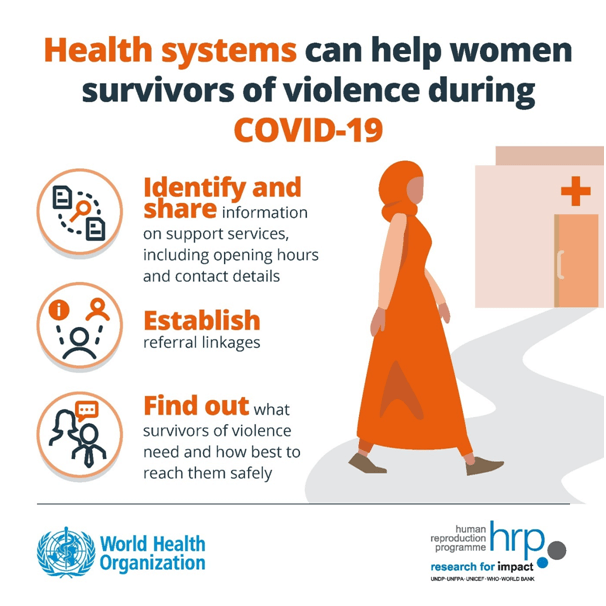
Let’s have a look at some of the social media marketing statistics for healthcare providers- (2023 Healthcare Marketing Statistics | Digitalis Medical)
- As per the statistics of 2021, 4.48+ billion users are active online
- 79% of users go to social media to find answers to health related questions
- 95% of users believe that social media is vital to reach patients after the pandemic hit
- 97% of social media users trust facebook to have access to health related information
Utilizing Email Marketing for Healthcare Promotion–
Email Marketing for healthcare works wonders in driving patient engagement. Email is the only marketing asset available for you, other than your website. The subscriber list literally shows that your patients want to receive an email from you, they want to stay updated. How often does that happen?
Most of the people are cautious about their health nowadays. They keep a keen eye on healthcare articles and emails that can help them stay fit and healthy. They want to get a sense of well-being. Since the audience is by default attracted to health issues, it becomes a prime opportunity for healthcare providers to put up the content there and give their patient subscribers a healthy dose of information every day.
Experts can’t agree enough to this that email marketing helps to build long-lastingrelationships with patients. Besides acquiring new patients, healthcare email marketing can retain patients. It works because an email directly reaches their patients and creates an emotional bond. It’s like a health newspaper that gets delivered to their inbox daily.
According to some trusted resources, the conversion rate for emails is 3* of social media promotional activities. If targeted right, emails can prove to be a great tool in retaining patients for a long time.
Let’s have a look at some of the email marketing statistics for healthcare providers- (2023 Healthcare Marketing Statistics | Digitalis Medical)
- 8 billion active email users are there worldwide, as per the report by 2021.
- 60% of people agree to receive promotional messages via email.
- The average email open rate for the healthcare sector is 21.48%.
- 69% average click-through rate for healthcare email marketing.
Your email content matters-
- Those emails with a personalized subject line have 50% higher open rates
- There is a 74% increased conversion from professionally written follow-up emails
How to measure the success of your digital marketing efforts?
Measuring the success of your digital marketing efforts is very important to grow, rectify mistakes and reach your target audience. There is a huge list of metrics to measure success, but here is the compilation of the most important ones every healthcare marketer should consider-
- Overall website traffic – Your website is basically your DIGITAL ADDRESS. It is the face of your brand. Most of all your digital marketing efforts will focus on driving traffic to the website which ultimately leads to conversion. Measuring website traffic on a daily basis will provide you with an insight into which campaign is working and which is dead. If you see a steady decline in website traffic, you may have to consider troubleshooting it. There might be any broken links or technical issues deterring the visitors.
- New visitors vs returning visitors – This dual metric helps in finding the value of your website. The content you are putting out there is helpful for people or not. If the visitors return multiple times, it means that they found the information relevant and valuable.
When you keep updating your content on a regular basis ( eg blogs, links, webpage content) you can review the NEW vs RETURNING visitors metric to see the relevance of your content. - Page views – This is a very important metric measuring the total number of pages viewed. If there is any user who repeatedly visits the same page, it will trigger this metric. It becomes important to know how many pages on your website are being visited, to understand if the entire website is valuable or certain pages are.
- Conversion rate – With the help of Google Analytics, you can measure the conversions made on the website. The possibleconversions are-
- A subscriber
- A complete download
- An inquiry call
- A lead entry
- Impressions – If you are running a social media campaign, this particular metric is important for you. It tells you the overall number of views your advertisement or campaign gets. Sometimes, your browsing pattern is recorded and the same ad campaign is shown multiple times to the same person. Each time an impression is recorded, it’ll be counted as an individual.
- Reach – The posts you create and upload on social media are meant to reach a wider audience. This metric tells you exactly how many people saw your content. The number of people reached will always be larger than the number of people who engaged with the social media post.
Sometimes, people get confused between reach and impressions. But there’s a difference. The reach metric is only triggered once per user and the impressions metric gets triggered even if the ad is clicked multiple times by the same user. - Email open rate – This metric measures the number of people who open your emails as compared to those who received your emails. In healthcare marketing, email open rate metric is particularly important because it shows your subscribers are willing to get healthcare updates, and are interested in your medical services.
Expert tips and strategies for healthcare organization digital marketing success
Since more and more people depend on google for healthcare solutions, it becomes important for healthcare providers to have a strong digital presence. Seeking a digital marketing agency that has a good experience with the healthcare industry can help a lot in long run.
Meanwhile, here are the few tips and strategies to ensure that your digital marketing efforts don’t go in vain-
- SEO is must
“Google only loves you when everyone else loves you first.”
–Wendy Piersall, Author, Blogger and Artist
For those who are new to the digital marketing world, SEO is a mix of strategies to bring relevant traffic to your website. It can include optimizing the website content forkeyword-specific searches. In healthcare, the possible keywords can be “health tips” “weight loss tips” “how to stay fit” etc
- Engaging in social media plan
“Amazing things will happen when you listen to the consumer.”
– Jonathan Midenhall
Its’ good practice to spend about half n hour per day promoting your services on social media, replying to queries, engaging with your followers, commenting on their posts, interacting with them in the comment section, and much more. If being a healthcare marketer, you’re not doing this then you’re turning your back from a big chunk of prospect patients.
It’s not necessary that you engage with your followers in every social media platform, instead, you can devise a strategy for one platform ( eg- LinkedIn ) and stick to it. In addition, schedule a live Q&A session per week, in which you answer the health queries LIVE. This will increase the trust and credibility of your brand and YOU in person.
- Put the word out there
“The most credible form of advertising is still a recommendation from a trusted friend. And that’s why customer testimonials are so powerful. They’re the next best thing to a personal referral.” – Bryan Eisenberg, Co-founder of Future Now Inc.
Client testimonials are very important in healthcare marketing. The feedback given by your patients can greatly influence the decision-making of people going through your website. A survey report says that 85% of people trust online reviews as they trust personal recommendations. Any positive word, thus, impacts significantly to a new person that just lands on your page/website.
- A compelling landing page
It is like an entry door to your digital address. It’s the first thing your visitors will notice. And obviously, “first impression is the last impression”. Your landing page design and content must be compelling enough for the visitor to stay, scroll down your website and spend a few minutes there. The design should be simple with attractive infographics. Place a CTA button at a prime location on your webpage. The call for appointment button is the most preferable and common CTA.
- Share information and educate them
“Healthcare marketing is not just about promoting a product or service, it’s about educating and empowering patients to make informed decisions about their health.”
Content marketing plays the biggest role in digital marketing realm. If used properly, it alone can make you a leader in the business. Sharing new content on your website, social media or blogs can educate the readers and increases your credibility. The content marketing approach actually builds a passive follower base without even selling your service directly to them.
A study in America shows that 72% of internet users go to the internet to find out symptoms, diagnosis, and treatment of any disease before consulting a doctor. So if you’re putting genuine in-depth information out there, you have the advantage of capitalizing on your potential patients.
- Video marketing
“Video has the power to humanize healthcare and bring a personal touch to an industry that can often seem distant and clinical. By showcasing real-life stories, procedures and treatments, video marketing has the potential to educate, inform and engage healthcare consumers like never before.”
Any message conveyed in the form of a video is retained for a longer time compared to reading it. Many doctors are now creating healthcare videos to generate awareness among people, be it dermatologists making a reel video to show skincare tips, or a bariatric surgeon uploading a video clip doing exercise & yoga to stay in shape.
Conclusion–
As the patients are becoming more tech-savvy, so should healthcare marketers. Medical information is more accessible today, which makes the consumers take charge of their healthcare journey. They are now more comfortable in using technology to research about health condition and its treatment options. Especially young generation, when they trust online reviews over anything else, investing in a strong digital presence becomes more important.
Connect with us the ultimate guidance to transform your Digital Marketing Strategy as a healthcare professional/ institute.


